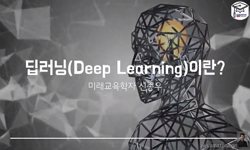알고리즘 편향성은 알고리즘 설계과정에서 트레이닝 데이터에서의 편견이나 모델과 데이터의 특성 사이의 조합에 의해 모델에 반영되는 편향을 의미한다. 최근에는 이러한 편향성이 딥러...
http://chineseinput.net/에서 pinyin(병음)방식으로 중국어를 변환할 수 있습니다.
변환된 중국어를 복사하여 사용하시면 됩니다.
- 中文 을 입력하시려면 zhongwen을 입력하시고 space를누르시면됩니다.
- 北京 을 입력하시려면 beijing을 입력하시고 space를 누르시면 됩니다.

성별의 알고리즘 편향성 감소를 위한 오토인코더 기반 딥러닝 모델 = Deep Learning Model based on Autoencoder for Reducing Algorithmic Bias of Gender
한글로보기https://www.riss.kr/link?id=A106324868
- 저자
- 발행기관
- 학술지명
- 권호사항
-
발행연도
2019
-
작성언어
Korean
-
주제어
algorithmic bias ; autoencoder ; latent space ; bias-variance dilemma ; deep learning ; 알고리즘 편향성 ; 오토인코더 ; 잠재공간 ; 편향-분산 딜레마 ; 딥러닝
-
등재정보
KCI우수등재
-
자료형태
학술저널
- 발행기관 URL
-
수록면
721-725(5쪽)
-
KCI 피인용횟수
0
- DOI식별코드
- 제공처
- 소장기관
-
0
상세조회 -
0
다운로드
부가정보
국문 초록 (Abstract)
알고리즘 편향성은 알고리즘 설계과정에서 트레이닝 데이터에서의 편견이나 모델과 데이터의 특성 사이의 조합에 의해 모델에 반영되는 편향을 의미한다. 최근에는 이러한 편향성이 딥러닝 모델에서 나타날 뿐만 아니라 증폭된다는 연구가 진행되면서 편향성 제거에 관한 문제가 제기되고 있다. 본 논문에서는 성별에 의한 알고리즘 편향성을 편향-분산 딜레마의 관점에서 분석하며 편향성의 원인을 규명하였고 이를 해결하기 위해 심층 오토인코더 기반 잠재공간 일치모델을 제안한다. 우리는 딥러닝에서의 알고리즘 편향성은 모델 내부의 특징 추출부분에서 보호특징별 잠재 공간이 다르다는 것을 실험으로 보여주었다. 본 논문에서 제안하는 모델은 성별특징이 다른 데이터를 동일한 잠재공간으로 전사시킴으로써 추출된 특징의 차이를 줄여 저편향성을 달성하였다. 우리는 정량적 평가지표로 Equality of Odds와 Equality of Opportunity 를 사용하여 기존모델에 비해 편향성이 낮음을 입증하고 ROC 곡선으로 통해 성별사이의 예측결과의 편차가 줄어들었음을 확인하였다.
다국어 초록 (Multilingual Abstract)
Algorithmic bias is a discrimination that is reflected in the model by a bias in data or combination of characteristics of model and data in the algorithm. In recent years, it has been identified that the bias is not only present but also amplified in...
Algorithmic bias is a discrimination that is reflected in the model by a bias in data or combination of characteristics of model and data in the algorithm. In recent years, it has been identified that the bias is not only present but also amplified in the deep learning model; thus, there exists a problem related to bias elimination. In this paper, we analyze the bias of the algorithm by gender in terms of bias-variance dilemma and identify the cause of bias. To solve this problem, we propose a deep auto-encoder based latent space matching model. Based on the experimental results, it is apparent that the algorithm bias in deep learning is caused by difference of the latent space for each protected feature in the feature extraction part of the model. A model proposed in this paper achieves the low bias by reducing the differences in extracted features by transferring data with different gender characteristics to the same latent space. We employed Equality of Odds and Equality of Opportunity as a quantitative measure and proved that proposed model is less biased than the previous model. The ROC curve shows a decrease in the deviation of the predicted values between the genders.
참고문헌 (Reference)
1 A. Datta, "Proxy Non-Discrimination in Data-Driven Systems"
2 B. Zhang, "Mitigating Unwanted Biases with Adversarial Learning" 2018
3 R. Zemel, "Learning Fair Representations" 325-333, 2013
4 A. Koene, "IEEE P7003TM Standard for Algorithmic Bias Considerations" 38-41, 2018
5 T. Kamishima, "Fairness-Aware Learning through Regularization Approach" 643-650, 2011
6 M. B. Zafar, "Fairness beyond Disparate Treatment &Disparate Impact : Learning Classification without Disparate Mistreatment" 1171-1180, 2017
7 M. Hardt, "Equality of Opportunity in Supervised Learning" 3315-3323, 2016
8 N. Kilbertus, "Avoiding Discrimination through Causal Reasoning" 656-666, 2017
1 A. Datta, "Proxy Non-Discrimination in Data-Driven Systems"
2 B. Zhang, "Mitigating Unwanted Biases with Adversarial Learning" 2018
3 R. Zemel, "Learning Fair Representations" 325-333, 2013
4 A. Koene, "IEEE P7003TM Standard for Algorithmic Bias Considerations" 38-41, 2018
5 T. Kamishima, "Fairness-Aware Learning through Regularization Approach" 643-650, 2011
6 M. B. Zafar, "Fairness beyond Disparate Treatment &Disparate Impact : Learning Classification without Disparate Mistreatment" 1171-1180, 2017
7 M. Hardt, "Equality of Opportunity in Supervised Learning" 3315-3323, 2016
8 N. Kilbertus, "Avoiding Discrimination through Causal Reasoning" 656-666, 2017
동일학술지(권/호) 다른 논문
-
3GPP 5G 시스템에서의 데이터 연결성을 위한 효율적인 접속 제어 방안
- 한국정보과학회
- 김석규
- 2019
- KCI우수등재
-
- 한국정보과학회
- 이수진
- 2019
- KCI우수등재
-
Bi-LSTM 기반 감성분석을 위한 대용량 학습데이터 자동 생성 방안
- 한국정보과학회
- 최민성
- 2019
- KCI우수등재
-
데이터 재사용을 고려한 효율적인 연속 서브 그래프 매칭 기법
- 한국정보과학회
- 최도진
- 2019
- KCI우수등재
분석정보
인용정보 인용지수 설명보기
학술지 이력
| 연월일 | 이력구분 | 이력상세 | 등재구분 |
|---|---|---|---|
| 2021 | 평가예정 | 계속평가 신청대상 (등재유지) | |
| 2016-01-01 | 평가 | 우수등재학술지 선정 (계속평가) | |
| 2015-01-01 | 평가 | 등재학술지 유지 (등재유지) |  |
| 2002-01-01 | 평가 | 학술지 통합 (등재유지) |  |
학술지 인용정보
| 기준연도 | WOS-KCI 통합IF(2년) | KCIF(2년) | KCIF(3년) |
|---|---|---|---|
| 2016 | 0.19 | 0.19 | 0.19 |
| KCIF(4년) | KCIF(5년) | 중심성지수(3년) | 즉시성지수 |
| 0.2 | 0.18 | 0.373 | 0.07 |




 DBpia
DBpia







